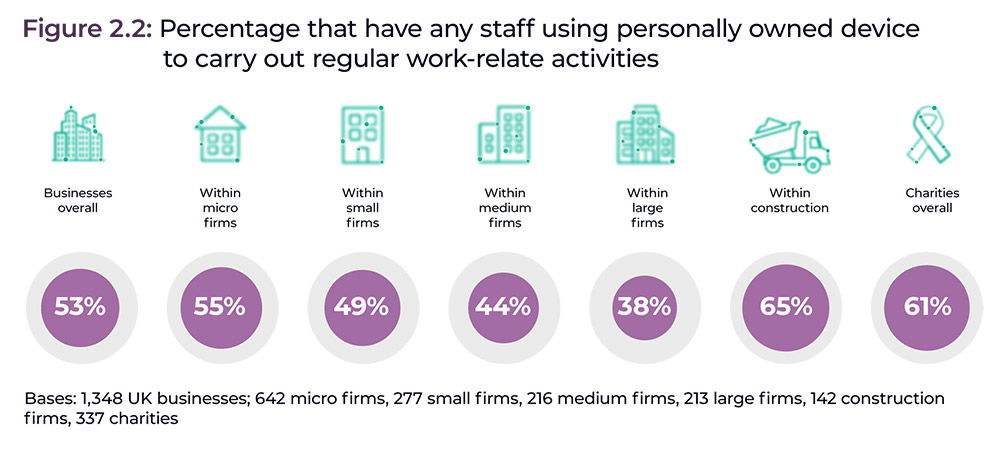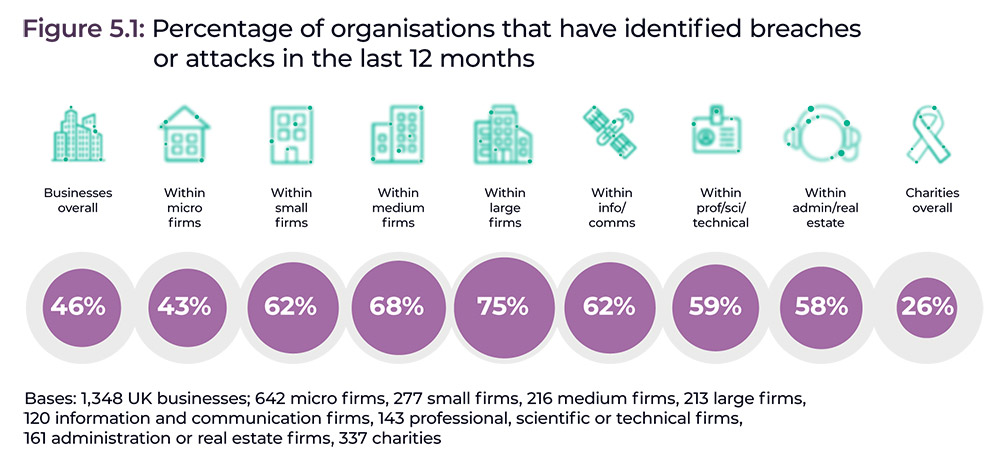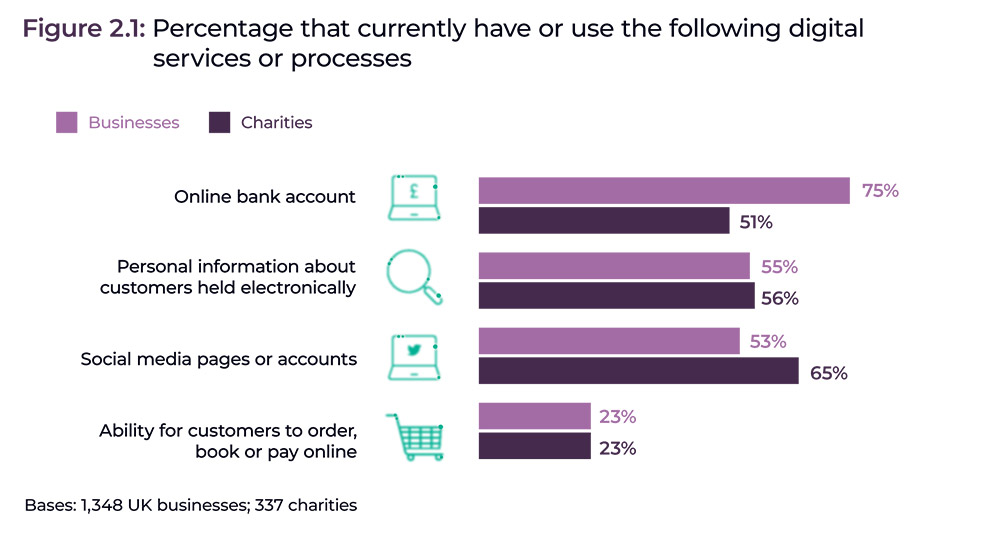While each one of these does present a cost in itself, the long-term financial and operational benefits are far greater. From increased agility, easier budgeting, driving productivity to better customer service, 2021 presents forward-thinking businesses with the opportunity to reimagine their network Infrastructure and processes to ensure a safe financial future with a business that can better reach its full potential.
Wi-Fi Infrastructure
In this new world of mobile productivity (as well as in the modern office), the increasing use of tablets and mobiles means that reliable, high-speed and secure wireless internet access is moving up the to-do list of many businesses and its importance can’t be understated.
For those that aren’t already leveraging wireless connections for computers, old-school ethernet cables are a tried and tested solution. Plus, wireless connections are known for slower speeds and unreliable connections when compared to a good-old-fashioned point to point connection. However, cabling an entire building is expensive and time consuming, especially if you’re having to move workspaces around to ensure employee safety as we start returning to the office. Then, on top of the cost of the physical cable itself, there’s the ongoing cost of maintaining them and paying for call-outs and engineers to fix any faults that arise.
A well-deployed Wi-Fi network solves all these issues. Devices can connect wirelessly meaning no spaghetti junctions underneath desks and chunky sidebars routing all the cables across rooms and floors. If routers need troubleshooting, most if not all adjustments can be made remotely, and replacing a router is far easier, with plug-and-play functionality and advanced settings pre-programmed by the supplier – if you’re working with the right IT partner that is.
New trends in Wi-Fi
Wi-Fi 6
Wi-Fi 6 is the newest industry standard for Wi-Fi, which brings with it faster speeds, stronger connections with devices and more robust security standards to protect businesses from losing their precious information.
Two-factor authentication
Especially useful when accessing business-critical or personal information, as well as in BYOD policies, two-factor authentication ensures the right person is logging on to your remote systems and Cloud services.
Say for example you need a login and password to sign-in (that’s the first ‘factor’), staff may then receive a code to their phone to enter into the login screen, or plug in a USB dongle, as the second ‘factor’ to double-check the credentials of the person logging in.
Wi-Fi mesh networks
If you think of all the Wi-Fi routers in your office as the spokes coming off the main hub of your central data system, a mesh network interlinks all those separate spokes with each other, not just the main hub. This means data can travel via multiple routes, ensuring the fastest possible speeds.

Tips for getting most out of you home Wi-Fi
Clear line of sight
Try to make sure your router can see your device – literally! Obstacles like walls, kitchen appliances and other physical blockages may well reduce speed and signal strength.
Reduce demand on the router
It may seem basic, but the more devices using your connection, the less Bandwidth you’ll enjoy. There are the obvious situations like kids playing on their X-Box or your partner watching Netflix, but even devices like phones, media players, smart appliances – even if you’re not using them – may affect the speed of the connection. So, try to only have devices that you need connected when you need them.
Use different wavelengths
Many modern routers work over 2 different wavelengths: 2.4 and 5 GHz and each has their own benefits and drawbacks.
2.4 GHz is a shorter wavelength, meaning it travels easier through the sorts of obstacles mentioned before, however the Bandwidth will be slightly lower. On the other hand, 5GHz frequencies are best if you need the fastest connection possible and have a clear line of sight to your router.
If all else fails, try a cable
If none of these solutions make a difference, you’re either using your connection to its potential, or the router itself may be impeding the speeds.
Try plugging a cable directly from the router to the computer and see if the speeds and reliability improves. If you’re still having troubles, then the issue is most likely with the physical router or a under-performing connection from your ISP.
Work from home tips
Take regular breaks
Staying in one room all day, especially when you’re stuck at home can be a real mind-bender, so make sure you give yourself moments to gather yourself through the day and give yourself the opportunity to get some fresh air … even if it is 5 minutes in the garden!
Prepare your lunch before the day starts
Try to prep your meals in the morning, then you’re not having to take more of the time out of your day to make your food, and have the smell lingering for the rest of the day, distracting you from your tasks.
Check in on colleagues
We all know just how hard lockdown has been, maybe one of your regular breaks is calling a colleague to see how their day has been? Not only does it give you (and them) chance to vent any frustrations that have been building over the day, but it helps to build team spirit and camaraderie with your cohorts.
Treat each day like you’re in the office
The temptation to only get dressed from the wait-up is a strong one, but it doesn’t help to keep your mind in work-mode. The more you treat your days working from home as a normal day in the office, the more you’ll get done.
Give yourself time to switch off
When that fateful time to clock off comes, make sure you give yourself some time to wind-down before you switch to home-mode. If you have a to-do list, make sure it’s up to date, you’ve dotted the I’s, crossed the T’s and all your emails are all sent. Then you can enjoy your evenings rather than worrying about what you’ve forgotten.
Whether you’re on-site or at home, reliable and secure wireless access is important, as is making sure your remote workers have the right tools to help them perform to their potential.
With over 150 years of combined experience, Mooncomputers can help make that a reality for you and your team. We’re even offering FREE work-from-home evaluations and Wi-Fi surveys, so what’s stopping you? Get yours today!
Cybersecurity
Throughout the pandemic and given the number of people working from home, businesses have seen an increased number of phishing attacks, and other Cybersecurity threats that risk the long-term operation of the business. Considering the future is only becoming even more digitally focused, investing in strong digital locks is one of the wisest moves you can make.
Take for example, recent figures from the Department for Digital, Culture, Media and Sport that show how nearly half of all businesses (and over a quarter of all charities) fell victim to some form of attack in 2019, and those numbers will have only risen since the pandemic!

What are the risks of poor Cybersecurity?
Especially if you run any sort of e-commerce or if you store customer information, robust Cybersecurity is essential and the ramifications for not securing the data are vast. First there are GDPR penalties which could amount to 5% of your entire years’ income, then there’s the effect on your brand credibility if the attack gains any sort of public press. Any existing customers may second guess their agreements with you, and all of this is before we get to any legal ramifications from other businesses and individuals whose data may have been compromised in the process! Combined, even a small attack that is not immediately dealt with can quickly snowball into a PR nightmare that can destroy the long-term viability of your business.
If you’re using any of the digital services below, then securing your operations should be paramount.

What sort of cyberattacks are businesses facing?
Among the 46 per cent of businesses and 26 per cent of charities that have experienced breaches or attacks in 2019, phishing attacks are considered by far as the most disruptive types of attack that organisations face.
What’s more we’ve seen a rise in phishing attacks since the pandemic started. Emails may appear to be government-sent noticed about Covid-19 guidelines or from the NHS about booking a vaccination slot, but really the end goal is for the victim to offer important personal information – passwords, bank details, personal details like date of birth etc. – that can be leveraged to gain further access into a business’ systems or used to access bank accounts or other personal services.
We’ve even seen attacks this International Women’s Day, masquerading a phishing attack as an Adidas webpage where unsuspecting victims would give their details to enter a raffle draw for new shoes. In short, these sorts of low-lives will stoop as low as required to pry valuable details from everyday people. If there’s one piece of advice we could give to try and prevent phishing attacks it’s that if you receive an offer that seems too good to be true, or from someone you have no knowledge of, it probably is.
But that’s only one type of attack. The installation of viruses, spyware, malware and even ransomware (that locks you out of your devices until you pay a ransom) are all incredibly dangerous for businesses. Not only because it prevents you from using your services as you need to, but it then becomes much harder to see what files and documents may have been compromised and can have very long-lasting effects that take years to resolve.

How do businesses increase their Cybersecurity?
The first thing to do is to speak to an expert. Cybersecurity is an ever-evolving concern because the technology used to develop these attacks is constantly improving and adapting to whatever countermeasures are commonly adopted. This means that only someone who lives and breathes Cybersecurity can advise you on where your individual vulnerabilities are and how to address them.
Of course, there are steps you can take yourself. Researching password best practices, researching and informing staff on how to identify phishing attacks, for example. If you want to know more, the best place to start is the government’s NCSC site, which contains plenty of useful articles and guides, like their 10 Steps to Cyber Security.
But considering your time is already stretched with all the other challenges that Covid-19 has wrought, we’d like to offer our support and assistance. Our engineers go through regular testing and accreditations to ensure they’re up-to-speed on the latest attack vectors and technologies. So, if you need to protect your digital operations, we’re only ever a call away.
Adopt the Cloud
Even before the pandemic pushed us all further online, ‘The Cloud’ was the most in-vogue term for business productivity and technology, even if it’s a catch-all term for any service where your data is stored online. You’re probably already using Cloud technology in your personal life. From G-mail, to Find My iPhone, Zoom to 1Password – all of these services are consumer-facing Cloud services which many businesses use every day.
Then there’s business-specific Cloud services like Unified Communications, data Hosting, co-location, Big Data processing and plenty more. The move to remote working pushed this adoption even further, and many businesses had to adopt new services like internet-based telephony services just to stay operational. However, there are plenty of long-term justifications to embrace the Cloud.
Benefits of moving services to the Cloud
Cost
One of the biggest benefits is cutting your outgoings. Running your own Server and PBX hardware is expensive; not only to buy, but to maintain, cool, fix and upgrade. Because Cloud services are usually per-month OpEx costs, they are far easier to budget for long-term and require less (if not, no) capital expenditure that could be better used transforming your office space for the return, post-lockdown.
Flexibility
Internet-based telephony solutions like VoIP and UC offer your staff a far more flexible way of working. They can all be reached using their office lines on all their devices from wherever they may be, meaning less missed calls, more immediate answers and the ability to adopt a more hybrid working model where staff can work from home on a regular basis, or whenever the need arises.
Then there’s the ability to add more services, or even reduce services far quicker, ensuring your business remains agile and able to react to changing markets and customer behaviour. Plus, as you don’t own any of the hardware, you’re not paying for fixes or hardware upgrades, which are all covered by the service providers.
Productivity
So, we’ve discussed how Cloud-based calling solutions enable better productivity but there’s a lot more that’s possible. Data centres can crunch mind-boggling large amounts of data to find customer behaviour patterns that you may not have realised and host your new online sales platform to maintain revenue while customers can’t visit physical locations. All without you having to invest in the hardware.
Security
Another massive benefit, especially for smaller businesses, is the ability to rely on some of technologies biggest names to protect their data. Amazon and Microsoft are two heavyweights in this space and have entire buildings full of staff dedicated to ensuring your data doesn’t fall into the wrong hands, using military-grade Encryption to prevent unauthorised access.
Then there’s the benefit of having an off-site back-up of all your data, so that in the case of fire, theft, flood or any other damage to your on-site systems, you have an up-to-date copy of all your information ready and waiting to be downloaded, so you can pick up from exactly where you left off.
Customer Service
The ways in which customers want to communicate with businesses is changing. New methods such as chatbots and instant messaging are growing massively, and businesses need to be able to meet these new demands to better compete. Leveraging the Cloud makes adopting these new methods far easier, cheaper and quicker, so what’s to lose?
The insights and reporting available within many Cloud services also help you take a bird’s eye view of your operation to better understand where improvements need to be made and resources need to be invested.



